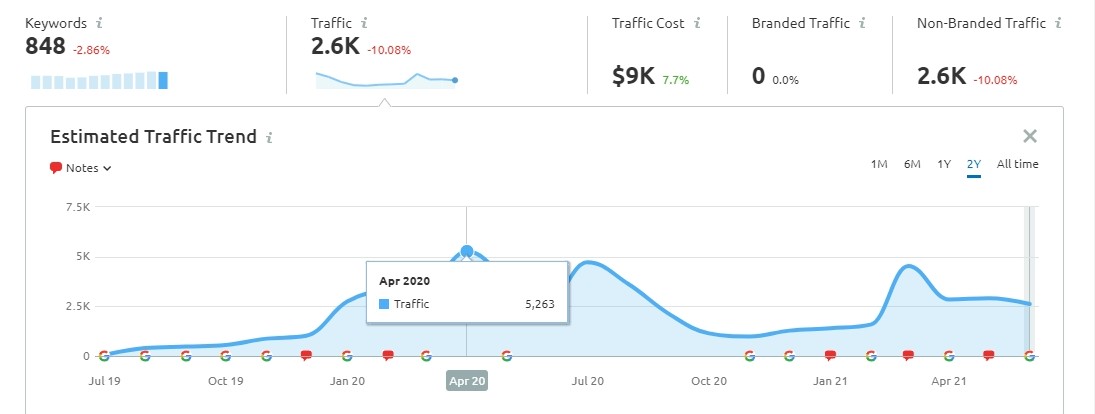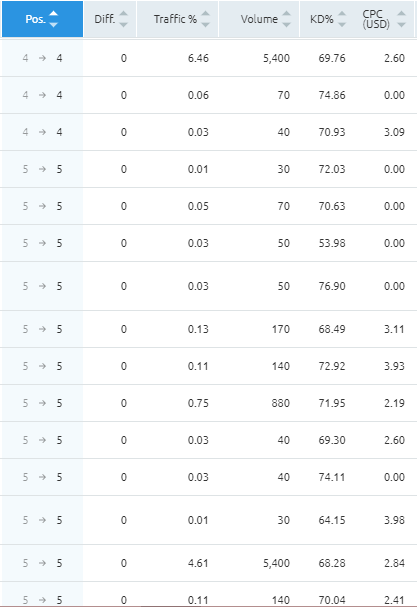How We Grew This SaaS Company’s Organic Traffic By 36% Month Over Month Using The Skyscraper Technique
Some Quick Highlights:
Readers Found The Content Helpful
The client has been getting feedback from readers who informed him that they found the content valuable and helpful.
1300+ Organic Keywords
From ranking for 49 keywords when it was published, this page is now a top traffic source and ranks for over 1300 keywords. With at least 100 keywords ranking in the top 3 positions.
Top Traffic Source For The Client
The page consistently ranks on the first page of Google month over month bringing in high-quality traffic.
36% Organic Traffic Increase
Using the skyscraper technique, we helped a SaaS client grow its organic traffic by 36% month over month.
Content Upgrade Converts at 20%
We developed a content upgrade for this page to drive user signups and it converts at 20%
Ranks #2 In The United States For Its Main Keyword
At a point, it was occupying the featured snippet spot for its keyword. Right now, it ranks #2 in the United States.
About the Client:
The company is a bootstrapped SaaS business operating in the B2B and B2C space. They help companies and business owners to create and document their procedures, processes, and tasks, all in one place.
Most of their customers are business owners and managers who want to systematize their business process, onboard their new employees more efficiently, and create a knowledge base for their clients and customers.
It operates majorly in the project management space and has lots of direct and indirect competitors such as Bizmanualz, Trello, Clickup, Trainual, and so on.

The Skyscraper Technique: What it Entails
The skyscraper technique is a strategy created and formulated by Brian Dean, Founder of Backlinko, and it basically involves the following steps:
Choose a keyword that you want to rank for
Figure out what other websites on the SERPs currently ranking for that keyword are doing right
Use what you found as a benchmark to create your own post
Make sure that the post you create is better in all ramifications (Make it the best piece on the planet for that keyword)
Optimize for user and search intent
And so many more.
Please note that the original version of the skyscraper technique has been updated to a new version. That said, I’ve made sure to include all the steps in the two versions here.
Challenges Faced By The Client Before Working With Us
Before hiring our agency to work on this project, the client already engaged another service provider. But due to the nature of the keyword and the ranking pages in SERPs, it was difficult to find a content angle to choose.
According to him:
“We want to be the best in-depth article for that keyword. Essentially make ours 1000% much better than what’s already ranking on the SERPs. Hence we want to create a definitive guide for that keyword and use a relevant design structure for the content.”
Not only that, he wanted a piece of content that paint the pains of someone searching for the keyword, agitate them, and then promise the solution.
In his words:
“Put yourself in the mind of the person who types the keyword into Google. I want the content to satisfy the search intent. So, 90% of the content should be focused on the keyword, the how, the why, examples and use-cases.”
With these in mind, we went to the drawing board and mapped out our own unique strategy for the piece by leveraging on our SaaS content writing (and marketing) experience.
How We Approached The Skyscraper Technique (Using Our Unique Strategy)
To help our clients achieve the results they envisaged for this project, we implemented a unique strategy and twist to the skyscraper technique.
Here’s exactly what we did:
The Results: How Has This Page Fared Since The Client Published It
The page was originally published somewhere around June 2019 and has grown in leaps and bounds since then.
I’ll be using SEMrush to show you some of the results for this page after publishing it.
Organic Keywords Trend:

As you can see, the organic keywords have been growing since it’s been published.
Summary:
From ranking for about 49 keywords during the first month it was published, it now ranks for more than 1300+ keywords on Google.
Traffic Statistics

As you can see, from the US alone:
- It’s currently ranking for 848 organic keywords
- Bringing in an estimated 2600 visitors per month
- The current traffic cost is around $9,000 if it were to be paid for via Google Ads.
- The traffic spiked in April 2020 and was bringing in about 5,263 organic traffic
Summary:
From just bringing in organic traffic of 11 during the first month it was published, it currently generates an average of 1000 organic traffic consistently every month.
Keywords It’s Ranking For

Summary:
It’s ranking for some high-intent keywords that are relevant to the client’s business.
Feedback From the Client About The Results From This Project
“That article you wrote for us using the skyscraper technique is a top traffic source for our website. The content upgrade currently has a 20% conversion rate. It currently ranks #3 in the United States (US) right now, and many of our customers and audience who’ve read it reach out to us from time to time that they found the piece helpful and valuable”
TL;DR:
- The page is a top traffic source
- The content upgrade has a 20% conversion rate
- It currently ranks #3 in the United States
- Readers found the piece valuable and helpful
Want to drive conversions and qualified traffic for your SaaS business?
You’re in the right place.
We don’t create content to fill the gap. We drive user signups and win new customers.
Full-service engagement starts at $5,000 per month.
